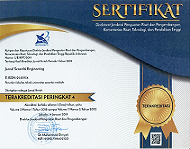Efektifitas Unit Intake, Aerasi, Pra-klorinasi, Koagulasi, Flokulasi di Instalasi Pengolahan Air (IPA) 2 Krian
Keywords:
efektivitas, IPA 2 Krian, Intake, Aerasi, Pra Klorinasi, Koagulasi, FlokulasiAbstract
This study aims to evaluate the effectiveness of water treatment process units including intake, aeration, pre-chlorination, coagulation, and flocculation at the Krian 2 Water Treatment Plant (IPA). Each unit has an important role in ensuring the quality of raw water into clean water that meets standards. The evaluation was carried out using a quantitative descriptive approach, using primary and secondary data obtained from field observations and laboratory tests. The results showed that the intake unit functioned quite well in supplying raw water with a stable discharge. The aeration unit was able to increase dissolved oxygen levels and reduce iron (Fe) and manganese (Mn) levels. The disinfection process showed effectiveness in reducing the number of pathogenic microorganisms, although it was influenced by the dose and contact time. The coagulation and flocculation units worked effectively in reducing turbidity and suspended solids through the addition of coagulant chemicals, namely PAC. Overall, the processing units at IPA 2 Krian have shown quite good effectiveness in producing clean water, although there are several technical aspects that need to be optimized to increase process efficiency.
References
[1] N. Hendrasarie, K. Fadilah, and M. R. Ranno, “Sequencing Batch Reactor to Treatment Tofu Wastewater Using Impeller Addition,” J. Ecol. Eng., vol. 23, no. 11, pp. 158–164, 2022, doi: 10.12911/22998993/153491.
[2] H. Novirina and F. I. Zarfandi, “Integrated Anoxic-Oxic Sequencing Batch Reactor Combined with Coconut Fiber Waste as Biofilm and Adsorbent Media,” J. Ecol. Eng., vol. 24, no. 11, pp. 176–189, 2023, doi: 10.12911/22998993/170994.
[3] D. Pengolahan and L. Berminyak, “Issn 1907-5626,” vol. 2, no. 2, 1907.
[4] F. Z. J. Z. Jannah, M. S. Zuhri, and E. Mulyadi, “Optimasi Kadar Ozon Dalam Proses Disinfeksi Bakteri Coliform Pada Pengolahan Air Minum,” J. Tek. Kim., vol. 15, no. 2, pp. 59–65, 2021, doi: 10.33005/jurnal_tekkim.v15i2.2567.
[5] C. Rahma and C. R. Niani, “Penggunaan Tawas (Al2(SO4)3) dalam Menurunkan Kadar Total Suspended Solid Air Limbah Batubara,” J. Optim., vol. 7, no. 1, p. 60, 2021, doi: 10.35308/jopt.v7i1.2562.
[6] Bambang Priadie, “Teknik Bioremediasi Sebagai Alternatif Dalam Upaya Pengendalian Pencemaran Air,” J. Ilmu Lingkung., vol. 10, no. 1, pp. 38–48, 2012, [Online]. Available: http://ejournal.undip.ac.id/index.php/ilmulingkungan
[7] Dr. SUGIONO, Metode Penelitian Kuantitatif, Kualitatif, Dan R & D, vol. 11, no. 1. 2019. [Online]. Available: http://scioteca.caf.com/bitstream/handle/123456789/1091/RED2017-Eng-8ene.pdf?sequence=12&isAllowed=y%0Ahttp://dx.doi.org/10.1016/j.regsciurbeco.2008.06.005%0Ahttps://www.researchgate.net/publication/305320484_SISTEM_PEMBETUNGAN_TERPUSAT_STRATEGI_MELESTARI
[8] U. Atikah, R. Purnaini, and G. C. Asbanu, “Analisis Kualitas Air Baku dan Kualitas Air Hasil Produksi pada Instalasi Pengolahan Air (IPA) Unit Mukok PDAM Tirta Pancur Aji Kota Sanggau,” J. Teknol. Lingkung. Lahan Basah, vol. 11, no. 2, p. 297, 2023, doi: 10.26418/jtllb.v11i2.64525.
[9] M. C. Hamonangan and A. Yuniarto, “Kajian Penyisihan Amonia dalam Pengolahan Air Minum Konvensional,” J. Tek. ITS, vol. 11, no. 2, 2022, doi: 10.12962/j23373539.v11i2.85611.
[10] A. Darmawan and A. Amalia, “Analisis Kinerja Instalasi Pengolahan Air Unit IV di PDAM Legundi Gresik,” vol. 6, no. 2, pp. 387–396, 2024.
[11] R. G. E. Bhaskoro and T. E. Ramadhan, “Evaluasi Kinerja Instalasi Pengolahan Air Minum (Ipam) Karangpilang I Pdam Surya Sembada Kota Surabaya Secara Kuantitatif,” J. Presipitasi Media Komun. dan Pengemb. Tek. Lingkung., vol. 15, no. 2, p. 62, 2018, doi: 10.14710/presipitasi.v15i2.62-68.
[12] D. P. Sriweni and N. Hendrasarie, “Efektivitas Jenis Media Pada Penurunan Kandungan Polutan Air Limbah Laundry Menggunakan Moving Bed Biofilm Reactor,” vol. X, no. 2, pp. 12742–12754, 2025.
[13] N. Hendrasarie, G. Nugroho, M. N. Trilita, B. Rahmat, M. H. P. Swari, and I. G. S. M. Diyasa, “CFD Simulation of the Effect of Adding a Sludge Zone to the Sequencing Batch Reactor for Fluid Turbulence,” in 2023 IEEE 9th Information Technology International Seminar (ITIS), 2023, pp. 1–6. doi: 10.1109/ITIS59651.2023.10420364.
[14] P. A. Wildanum and N. Hendrasarie, “Processing of Coagulation Flocculation Sequencing Batch Reactor (Sbr) in Kebon Agung River As Clean Water,” J. Enviromental Eng. Sustain. Technol., vol. 10, no. 2, pp. 75–87, 2023, doi: 10.21776/ub.jeest.2023.010.02.4.
[15] Z. Rahimah, H. Heldawati, and I. Syauqiah, “Pengolahan Limbah Deterjen Dengan Metode Koagulasi-Flokulasi Menggunakan Koagulan Kapur Dan Pac,” Konversi, vol. 5, no. 2, p. 13, 2018, doi: 10.20527/k.v5i2.4767.
Downloads
Published
Issue
Section
License
Copyright (c) 2025 Devi Mustika Sari, Novirina Hendrasarie (Author)

This work is licensed under a Creative Commons Attribution 4.0 International License.












